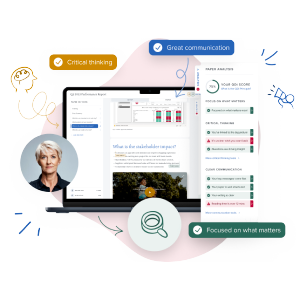After two months cooped up at home, you’d expect most of us to be eager to go back to life as before. But not board members. 76% will continue to hold remote meetings even when they’re able to meet in person, according to our latest research.
Why is that? Because beyond the technical and human challenges, 88% of them now view remote meetings as an opportunity to shake things up and improve the effectiveness of their board.
So, how can directors deliver on that goal? And how can they do it quickly, before boards settle in new habits and their newfound flexibility wanes?
Good online meetings are nothing more than good meetings
The first step is to acknowledge that virtual meetings are just that — meetings. It’s a false dichotomy to oppose the remote kind with the “physical” one. Often, what improves one also improves the other. So, don’t worry about wasting time on improving the way remote meetings are run: the good habits you pick up now will help you when you’re back in the boardroom.
Virtual board meetings aren’t intrinsically hard, either. If anything, it’s rather that physical meetings can be too easy: merely being in the room and nodding along may sometimes be enough to make you feel like you have contributed. In contrast, remote meetings require active participation to make your presence felt and your ideas heard. That’s not being harder — just less forgiving.
Meetings are meetings, and what they need to be effective isn’t a specific medium but good fundamentals.
Ask more of your governance team
Of these fundamentals, focus is the oft-forgotten one — yet, possibly the most important.
There’s ample debate around how long the average person can concentrate for. Common university lecturer wisdom holds that students’ attention starts dropping around the 15–20-minute mark (if you ever wondered why TED talks are precisely 18 minutes long, there’s your answer). But whatever the actual length, which will vary by age group and individual, it clearly isn’t eight hours or a day-long board meeting.
So, ask your secretariat, governance, or supporting team to change its ways. They must cut down the length of your agenda, and readdress where they’re having you spend your time (hint: it shouldn’t be on past minutes). A no-fuss way to get started is to use the Six Conversations Model and the Jar of Life. Technology can also be an ally: for example, could minutes be approved prior to the meeting, using e-signatures? Or could the board “marathon” be split into smaller board “sprints”, spread over several days?
In return, give your governance team a clear sense of what you want to focus on. Channel your inner Pareto, and define the four or five priorities that will truly matter and have the most impact. And be brutal — if you feel that you’ve covered everything, it’s probably not a good sign.
Lastly, because we lack the multiple visual clues we’re used to, engagement can be tricky in a virtual setting. So, ask one more favour from your secretariat and nominate a “chief participation officer.” Task that person with ensuring everyone has their say and that the director having trouble with the mute button is also sharing his or her valuable insight.
Ask more of your executives
A sharp, focused agenda only defines the roads your meeting will follow. The fuel that will make the board cruise along them is the board pack — and, here, it’s your management team’s habits that must evolve.
Research shows half of the average board pack is going unread, despite directors spending increasingly more energy poring over it. So, ask your authors to save everyone’s precious time and summarise everything in a 1-page executive summary. Again, don’t go for half measures — a report lacking a proper executive summary should simply not be accepted into the pack. Neither should something be added at the eleventh hour, only for the board to discover it on the day of the meeting.
In exchange, show your executives and authors the way. Define your brief with them before they even start writing. They’re not psychics, and they don’t have the context of your previous board meetings — therefore, clearly state what’s on your mind, what matters to the board, and what questions you want answers to. Give direct feedback afterwards, and ask for honest feedback on your brief as well.
Ask more of the board — and of yourself
Finally, ask yourself and your fellow board members: “Which of our own habits should we shed?”
If you are that one director still asking for a physical copy of the pack, now is the time to stop. Good board portals give you the same paper experience, but with a host of improvements that will help both you, your secretariat, and your authors. If you’re asking them to change their ways, so should you.
Use that technology to contribute early and often, and own your end of the board pack. Ask clarifying questions to your report writers, share comments with other directors ahead of time, and free as much time for the actual meeting as you can.
Some of the above may be tough asks, and many board members would rather focus on their main mission: helping the organisation; as opposed to rocking the boat. But this is a post-Covid-19 world — the boat has already capsized. While it may seem harsh to ask more of teams when half their members are on furlough, it’s also the perfect time to implement overdue change. So, seize the moment. Done well, your whole organisation will be better for it.





